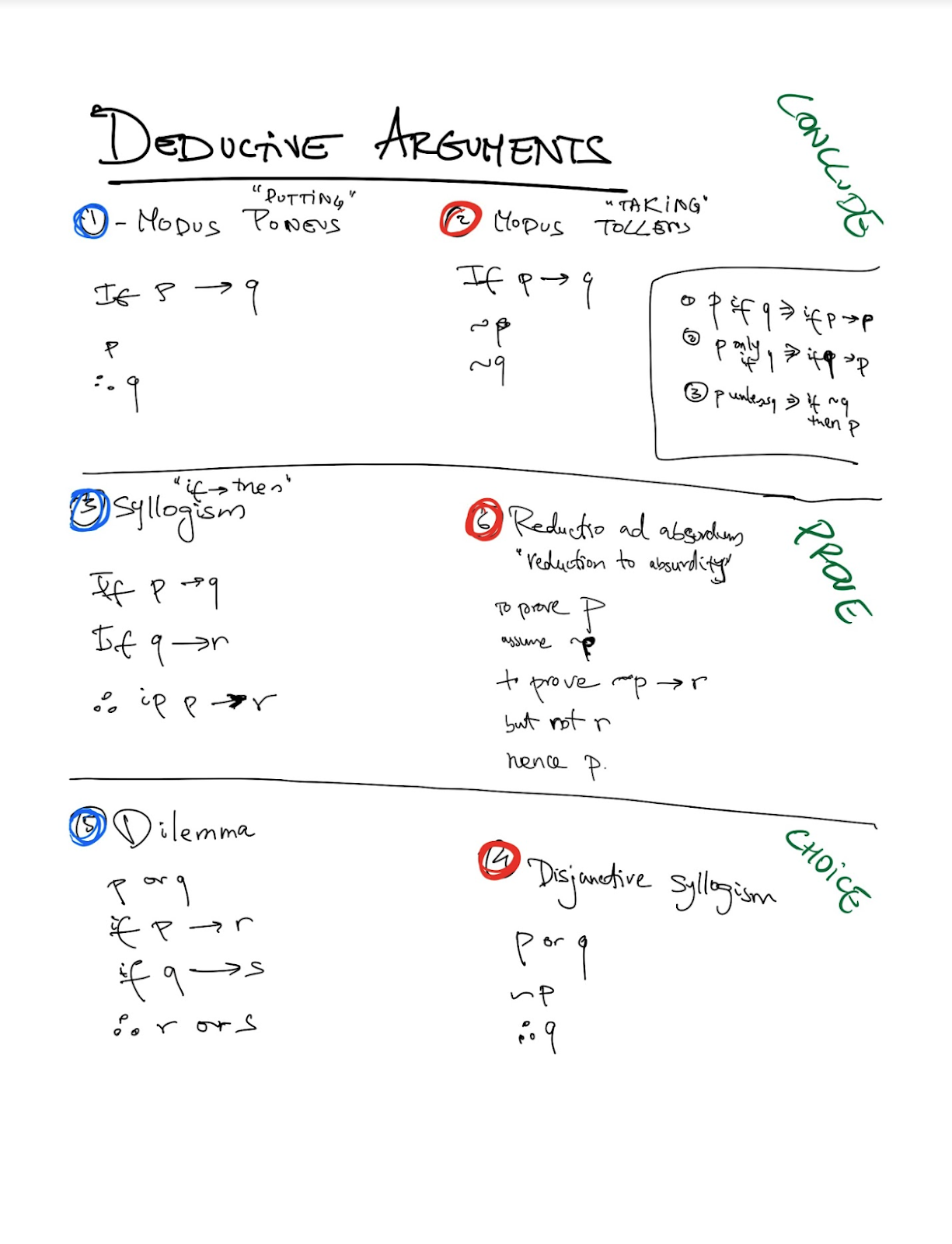Notes: Arguments
Workbook on Arguments
Link to book
- Ch1: Short arguments
- Rule 1: Identify premise and conclusion
- Rule 2: Develop you ideas in a natural order
- Rule 3: Start from a reliable premise
- Rule 4: Be concrete and concise
- Rule 5: Build on substance, not overtone
- Rule 6: Use consistent terms
- Ch 2: Generalizations
- Rule 7: Use more than one example
- Rule 8: Use representative examples
- Rule 9: Background rates may be critical
- Rule 10: Statistics needs a critical eye
- Rule 11: Consider counterexample
- Ch 3: Arguments by analogy
- Rule 12: Analogies require
- Ch 4: Sources
- Rule 13: Cite your sources
- Rule 14: Seek informed sources
- Rule 15: Seek impartial sources
- Rule 16: Cross-check sources
- Rule 17: Use the web with care
- Ch 5: Causes
- Rule 18: Causal arguments start with correlations
- Rule 19: Correlations may have alternate explanations
- Rule 20: Work towards the most likely explanations
- Rule 21: Expect complexity
- Ch 6: Deductive arguments
- Rule 22: Modus poneus
- Rule 23: Modus tollens
- Rule 24: Hypothetical syllogims
- Rule 25: Disjunctive syllogims
- Rule 26: Dillemma
- Rule 27: Reductio ad absurdum
- Rule 28: Deductive arguments in several steps
- Ch 7: Extended arguments
- Rule 29: Explore the issue
- Rule 30: Spell out the basic arguments
- Rule 31: Defend basic premises with arguments of their own
- Rule 32: Consider objections
- Rule 33: Consider alternatives
- Ch 8: Essays
- Rule 34: Jump right in
- Rule 35: Make a definite claim or proposal
- Rule 36: Your argument is your outline
- Rule 37: Detail objections and meet them
- Rule 38: Use your feedback
- Rule 39: Modesty
- Ch 9: Oral arguments
- Rule 40: Reach out to your audience
- Rule 41: Be fully present
- Rule 42: Signpost your argument
- Rule 43: Offer something positive
- Rule 44: Use visual aids sparingly
- Rule 45: End in style
- Ch 10: Falacies
- Ch 11: Definations
- Rule D1: When terms are unclear, get specific
- Rule D2: When terms are contested, work from the clear case
- Rule D3: Definitions don’t replace arguments

Logic 101
Link to course Link to playlist
Operations
- Negation:
~ - OR/Disjunction (inclusive):
v - XOR (exclusive):
- AND/Conjunction:
^ - Conditional:
P=>Q;Pis the antecedent,Qis the consequent - Bi-conditional (if and only if):
P<=>Q;Pis the antecedent,Qis the consequent
Truth Tables
Replacement Rules
Used to replace one expression with another.
- Double Negation:
P <=> ~~P - Material Implication:
P=>Q <=> ~PvQ- Helps convert conditionals to disjunctions
- Contraposition:
P=>Q <=> ~Q=>~P- Helps convert conditionals to conditionals
- De Morgan’s Law:
~(P^Q) <=> ~Pv~Q- Helps convert conjunctions to disjunctions
- Associativity:
- with conjunction:
(P^Q)^R <=> P^(Q^R) - with disjunction:
(PvQ)vR <=> Pv(QvR)
- with conjunction:
- Commutativity
- Distribution
- with conjunction:
P^(QvR) <=> (P^Q)v(P^R) - with disjunction:
Pv(Q^R) <=> (PvQ)^(PvR)
- with conjunction:
- Idempotence
- with conjunction:
P^P <=> P - with disjunction:
PvP <=> P
- with conjunction:
Rules of Inference
Help us draw conclusions from premises
- Modus Ponens:
P=>QPtherefore Q
- Modus Tollens:
P=>Q~Qtherefore ~P
- Disjunctive Syllogism:
PvQ~Ptherefore Q
- Hypothetical Syllogism:
P=>QQ=>Rtherefore P=>R
- Dilemma:
- Constructive:
P=>QR=>SPvRtherefore QvS
- Destructive:
P=>QR=>S~Qv~Stherefore ~Pv~R
- Constructive:
- Conjuction introduction
PQtherefore P^Q
- Simplification
P^Qtherefore P
- Biconditional:
- Biconditional elimination
P<=>Qtherefore P=>Qandtherefore Q=>P
- Biconditional introduction
P=>QQ=>Ptherefore P<=>Q
- Biconditional elimination
- Disjuction introduction
Ptherefore PvQ
Proofs
- Styles:
- Proof by contradiction
- Conditional proofs
- Tautologies
- Nested Proofs
- Biconditional tautologies
- Proof strategy:
- DeMorgan’s Everything
- Working backwards
- Proof by cases
Fallacies
- Affirming the consequent
- Denying the antecedent